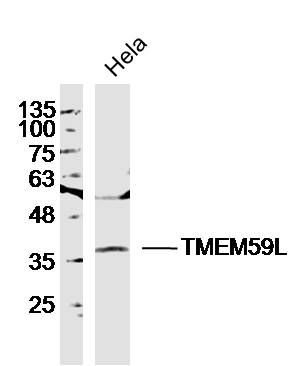产品货号 : mlR11648
英文名称 : TMEM59L
中文名称 : 跨膜蛋白59样蛋白抗体
别 名 : BSMAP; Brain-specific membrane-anchored protein; C19orf4; TM59L_HUMAN; Tmem59l; Transmembrane protein 59-like.
研究领域 : 神经生物学 信号转导 Alzheimer's
抗体来源 : Rabbit
克隆类型 : Polyclonal
交叉反应 : Human, Mouse, Rat, Dog, Pig, Cow, Horse, Sheep,
产品应用 : WB=1:500-2000 ELISA=1:500-1000 IHC-P=1:400-800 IHC-F=1:400-800 ICC=1:100-500 IF=1:100-500 (石蜡切片需做抗原修复)
not yet tested in other applications.
optimal dilutions/concentrations should be determined by the end user.
分 子 量 : 35kDa
细胞定位 : 细胞浆 细胞膜
性 状 : Lyophilized or Liquid
浓 度 : 1mg/ml
免 疫 原 : KLH conjugated synthetic peptide derived from human TMEM59L:251-342/342
亚 型 : IgG
纯化方法 : affinity purified by Protein A
储 存 液 : 0.01M TBS(pH7.4) with 1% BSA, 0.03% Proclin300 and 50% Glycerol.
保存条件 : Store at -20 °C for one year. Avoid repeated freeze/thaw cycles. The lyophilized antibody is stable at room temperature for at least one month and for greater than a year when kept at -20°C. When reconstituted in sterile pH 7.4 0.01M PBS or diluent of antibody the antibody is stable for at least two weeks at 2-4 °C.
PubMed : PubMed
产品介绍 : BSMAP is a 342 amino acid type-I membrane glycoprotein that localizes to organelle membranes and belongs to the TMEM59 family. Expressed at high levels in brain tissue, BSMAP is thought to play a role in brain function and central nervous system activity. The gene encoding BSMAP maps to human chromosome 19, which consists of over 63 million bases, houses approximately 1,400 genes and is recognized for having the greatest gene density of the human chromosomes. It is the genetic home for a number of immunoglobulin (Ig) superfamily members, including the killer cell and leukocyte Ig-like receptors, a number of ICAMs, the CEACAM and PSG family and Fc receptors (FcRs).
Function:
Modulates the O-glycosylation and complex N-glycosylation steps occurring during the Golgi maturation of APP. Inhibits APP transport to the cell surface and further shedding.
Subcellular Location:
Golgi apparatus membrane.
Tissue Specificity:
Expressed preferentially at high level in the brain.
Post-translational modifications:
Belongs to the TMEM59 family.
Similarity:
Belongs to the TMEM59 family.
SWISS:
Q9UK28
Gene ID:
25789
Important Note:
This product as supplied is intended for research use only, not for use in human, therapeutic or diagnostic applications.
产品图片












